Interesting links
Here are some interesting links for you! Enjoy your stay :)Categories
- Animals
- Augmented Reality
- Bing Maps
- Books
- Cartography
- Climate
- Conferences
- Crowdsourcing
- Data Sources
- Economy
- Education
- Environment
- ESRI
- Flash Maps
- Geography
- Geology
- GIS and Health
- Google Earth and Sky
- Google Maps and Mashups
- Health
- History
- Humor
- Map Art
- Mobile
- Pollitics
- Social Networking
- Technical
- Television
- Tools
- Trends
- Urban Planning
- Water
- Weather
- Website Design
- Wordpress
Archive
- October 2020
- September 2020
- May 2020
- March 2020
- July 2019
- November 2013
- September 2013
- April 2013
- March 2013
- February 2013
- January 2013
- December 2012
- November 2012
- September 2012
- July 2012
- June 2012
- May 2012
- April 2012
- February 2012
- December 2011
- November 2011
- September 2011
- August 2011
- May 2011
- March 2011
- February 2011
- January 2011
- December 2010
- September 2010
- July 2010
- February 2010
- October 2009
- July 2009
- June 2009
- May 2009
- April 2009
- March 2009
- December 2008
- November 2008
- October 2008
- September 2008
- July 2008
- June 2008
- May 2008
- April 2008
- March 2008
- February 2008
- January 2008
- December 2007
- November 2007
- October 2007
- September 2007
- August 2007

Wonders of Reddit – Colonial America
/in History, Pollitics /by Nina KFVery, very late to this game, I’m discovering the wonders of Reddit – specifically the subreddit “Map Porn“, and the title sums it up. For starter, there is this 1957 educational map created by Esso Standard Oil which was recently posted. The comments are also great, including critique that the Dutch flag and colors are wrong… and that this was an America without slavery!
Note also, that Seneca Indians in New York State used oil from a spring (second zoomed image) – apparently for medicinal purposes. Fun fact (as they say), this is recorded as the discovery of oil in America! Dive in here – also an interactive map website. No more oil here, but a rich history.
Conflict and Bridging Divides
/in Pollitics /by Nina KFThe website Armed Conflict Location & Event Data Project is a rich resource for data about conflicts and protests in the US and worldwide, with multiple links to other sites and databases. It is a bit shocking, but the story covers the last year and puts it all a bit into perspective, with much good background information. (Hoping it is all factual, which it is likely to be given the sponsors.)
Through a link on this site, to the Princeton Bridging Divide’s Initiative, an interactive map showing up-to-date conflict events and organizations in the US, with the ability to drill down and learn more about organizations or specific events.
So how does this make me feel? Amazed at how complex the US is, but also how great that there are so many organizations whose mission it is to “bridge the divides” in the currently very divided society. We don’t hear about these efforts in the news.
World Food Program
/in Climate, Pollitics, Weather /by Nina KFWorld Food Program won the Nobel Peace Prize 2020. The agency was given the prize for its efforts to combat hunger and improve conditions for peace.
This interactive “Hunger Map” contains an amazing amount of detail and links to numerous databases tracking the world situation on a daily basis.
Some of the indices and trends are not as clear as others, but this appears to be an amazing data resource. Overlays include vegetation, rainfall, crises of all sorts, conflicts, and COVID-19 cases and deaths.
Take Yemen…
Watch this map
/in Pollitics /by Nina KFWatch this map, updated 3 times a day from polls. https://www.270towin.com/maps/biden-trump-polling-map
COVID-19 Dominates
/in Health, Tools /by Nina KFSadly, the most viewed map these days is the Johns Hopkins COVID-19 Map developed with an ESRI ArcGIS Dashboard.
More maps built with ArcGIS can be found at https://coronavirus-resources.esri.com/, including the projected peak map developed by IHME at the University of Washington.
Wolf Tracking
/in Animals, Environment /by Nina KFWolves are awesome and endlessly fascinating, maybe because of their similarity to our favorite pets. One organization provides all the data, videos and some amazing maps, to satisfy the most die-hard wolf-lovers. As their Facebook says, Voyageurs Wolf Project studies wolves and their prey (moose, deer, and beavers) during the summer in the Greater Voyageurs Ecosystem, which includes the area in and around Voyageurs National Park, in northern Minnesota. These images, posted in Jan 2020, show the movements of various packs within the Voyager park area, generated by putting gps collars on pack members. There are unanswered questions as to whether some packs disappeared, new ones formed, etc.
For a day (or days) in the life of wolfie, check out Voyager’s website, and this page of animations.
Tracking Apps
/in Mobile, Tools /by Nina KFTraveling a lot these days, and hiking and biking. There must be a way to keep track of my travels, organize and georeference photos and video’s, take notes, maybe even record comments as I move around. So, I am looking at iPhone and android tracking apps. Here’s my starter list:
MyTracks, for Android
MyTracks for Apple (different publisher)
A collection of apps for tracking other people (e.g. kids)
Relive
A collection of apps for longer trips
Polarsteps for Android, and for iPhone.
Avenza is an mapp app which requires that you download maps to use offline – some free, need to explore — looks like an amazing map collection. You can search the database of maps online.
The David Rumsey Collection
/in Cartography, History /by Nina KFGerrymandering – the Line Dance
/in Pollitics, Tools /by Nina KFGeospatial trends in 2019
/in Trends /by Nina KF